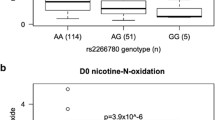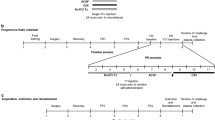Abstract
Rationale
Cyp2a5, the mouse homologue of human CYP2A6, encodes for the enzyme responsible for the primary metabolism of nicotine. Variation in human CYP2A6 activity can alter the amount smoked such as number of cigarettes smoked per day and smoking intensity. Different mouse strains self-administer different amounts of oral nicotine and quantitative trait loci analyses in mice suggested that Cyp2a5 may be involved in differential nicotine consumption behaviors.
Objectives
The goal of this study was to examine whether in vivo nicotine consumption levels were associated with CYP2A5 protein levels and in vitro nicotine metabolism in mice.
Methods
F2 mice propagated from high (C57Bl/6) and low (St/bJ) nicotine consuming mice were analyzed for CYP2A5 hepatic protein levels and in vitro nicotine metabolizing activity.
Results
We found that F2 male high-nicotine (n=8; 25.1±1.2 μg nicotine/day) consumers had more CYP2A5 protein, compared to low (n=11; 3.8±1.4 μg nicotine/day) consumers (10.2±1.0 vs 6.5±1.3 CYP2A5 units). High consumers also metabolized nicotine faster than the low consumers (6 μM: 0.18±0.04 vs 0.14±0.07; 30 μM: 0.36± 0.06 vs 0.26±0.13; 60 μM: 0.49±0.05 vs 0.32±0.17 nmol/min/mg). In contrast, female high- (25.1±2.1 μg nicotine/day) and low-nicotine (4.7±1.4 μg nicotine/day) consumers did not show pronounced differences in nicotine metabolism or CYP2A4/5 protein levels; this is consistent with other studies of sex differences in response to nicotine.
Conclusions
These data suggested that among male F2 mice, increased nicotine self-administration is associated with increased rates of nicotine metabolism, most likely, as a result of greater CYP2A5 protein levels.





Similar content being viewed by others
Abbreviations
- CYP:
-
cytochrome P450
- HNC:
-
high nicotine consumers
- LNC:
-
low nicotine consumers
- NCO:
-
nicotine C-oxidation
References
Aschhoff S, Schroff K-C, Wildenauer DB, Richter E (1999) Nicotine consumption of several mouse strains using a two bottle choice paradigm. J Exp Anim Sci 40:171–177
Benowitz NL, Jacob P 3rd (1985) Nicotine renal excretion rate influences nicotine intake during cigarette smoking. J Pharmacol Exp Ther 234:153–155
Benowitz NL, Jacob P III (1993) Nicotine and cotinine elimination pharmacokinetics in smokers and nonsmokers. Clin Pharmacol Ther 53:316–323
Benowitz NL, Jacob P III, Fong I, Gupta S (1994) Nicotine metabolic profile in man: comparison of cigarette smoking and transdermal nicotine. J Pharmacol Exp Ther 268:296–303
Brandange S, Lindblom L (1979) The enzyme “aldehyde oxidase” is an iminium oxidase. Reaction with nicotine delta 1′(5′) iminium ion. Biochem Biophys Res Commun 91:991–996
Burkhart BA, Harada N, Negishi M (1985) Sexual dimorphism of testosterone 15 alpha-hydroxylase mRNA levels in mouse liver. cDNA cloning and regulation. J Biol Chem 260:15357–15361
Collins AC, Miner LL, Marks MJ (1988) Genetic influences on acute responses to nicotine and nicotine tolerance in the mouse. Pharmacol Biochem Behav 30:269–278
Crawley JN, Belknap JK, Collins A, Crabbe JC, Frankel W, Henderson N, Hitzemann RJ, Maxson SC, Miner LL, Silva AJ, Wehner JM, Wynshaw-Boris A, Paylor R (1997) Behavioral phenotypes of inbred mouse strains: implications and recommendations for molecular studies. Psychopharmacology (Berl) 132:107–124
Damaj MI (2001) Influence of gender and sex hormones on nicotine acute pharmacological effects in mice. J Pharmacol Exp Ther 296:132–140
Dempsey D, Jacob P III, Benowitz NL (2002) Accelerated metabolism of nicotine and cotinine in pregnant smokers. J Pharmacol Exp Ther 301:594–598
Faraday MM, Blakeman KH, Grunberg NE (2005) Strain and sex alter effects of stress and nicotine on feeding, body weight, and HPA axis hormones. Pharmacol Biochem Behav 80:577–589
Grabus SD, Martin BR, Batman AM, Tyndale RF, Sellers E, Damaj MI (2005) Nicotine physical dependence and tolerance in the mouse following chronic oral administration. Psychopharmacology (Berl) 178:183–192
Harada N, Negishi M (1984) Mouse liver testosterone 15 alpha-hydroxylase (cytochrome P-450(15) alpha). Purification, regioselectivity, stereospecificity, and sex-dependent expression. J Biol Chem 259:1265–1271
Kiyotani K, Yamazaki H, Fujieda M, Iwano S, Matsumura K, Satarug S, Ujjin P, Shimada T, Guengerich FP, Parkinson A, Honda G, Nakagawa K, Ishizaki T, Kamataki T (2003) Decreased coumarin 7-hydroxylase activities and CYP2A6 expression levels in humans caused by genetic polymorphism in CYP2A6 promoter region (CYP2A6*9). Pharmacogenetics 13:689–695
Lee BL, Benowitz NL, Jacob P III (1987) Influence of tobacco abstinence on the disposition kinetics and effects of nicotine. Clin Pharmacol Ther 41:474–479
Lindberg RL, Juvonen R, Negishi M (1992) Molecular characterization of the murine Coh locus: an amino acid difference at position 117 confers high and low coumarin 7-hydroxylase activity in P450coh. Pharmacogenetics 2:32–37
Lush IE, Holland G (1988) The genetics of tasting in mice. V. Glycine and cycloheximide. Genet Res 52:207–212
Marks MJ, Burch JB, Collins AC (1983) Genetics of nicotine response in four inbred strains of mice. J Pharmacol Exp Ther 226:291–302
Marks MJ, Romm E, Bealer SM, Collins AC (1985) A test battery for measuring nicotine effects in mice. Pharmacol Biochem Behav 23:325–330
Marks MJ, Romm E, Gaffney DK, Collins AC (1986) Nicotine-induced tolerance and receptor changes in four mouse strains. J Pharmacol Exp Ther 237:809–819
Marks MJ, Romm E, Campbell SM, Collins AC (1989) Variation of nicotinic binding sites among inbred strains. Pharmacol Biochem Behav 33:679–689
McMorrow MJ, Foxx RM (1983) Nicotine’s role in smoking: an analysis of nicotine regulation. Psychol Bull 93:302–327
Merlo Pich E, Chiamulera C, Carboni L (1999) Molecular mechanisms of the positive reinforcing effect of nicotine. Behav Pharmacol 10:587–596
Messina ES, Tyndale RF, Sellers EM (1997) A major role for CYP2A6 in nicotine C-oxidation by human liver microsomes. J Pharmacol Exp Ther 282:1608–1614
Murphy S, Raulinaitis V, Brown KM (2005) Nicotine 5′-oxidation and methyl oxidation by P450 2A enzymes. Drug Metab Dispos 33:1166–1173
Nakajima M, Yamamoto T, Nunoya K, Yokoi T, Nagashima K, Inoue K, Funae Y, Shimada N, Kamataki T, Kuroiwa Y (1996) Characterization of CYP2A6 involved in 3′-hydroxylation of cotinine in human liver microsomes. J Pharmacol Exp Ther 277:1010–1015
Nakajima M, Yokoi T (2005) Interindividual variability in nicotine metabolism: C-oxidation and glucuronidation. J Drug Metab Pharmacokinet 20:227–235
Nakayama H, Okuda H, Nakashima T, Imaoka S, Funae Y (1993) Nicotine metabolism by rat hepatic cytochrome P450s. Biochem Pharmacol 45:2554–2556
Pitarque M, von Richter O, Oke B, Berkkan H, Oscarson M, Ingelman-Sundberg M (2001) Identification of a single nucleotide polymorphism in the TATA box of the CYP2A6 gene: impairment of its promoter activity. Biochem Biophys Res Commun 284:455–460
Rao Y, Hoffmann E, Zia M, Bodin L, Zeman M, Sellers EM, Tyndale RF (2000) Duplications and defects in the CYP2A6 gene: identification, genotyping, and in vivo effects on smoking. Mol Pharmacol 58:747–755
Robinson SF, Marks MJ, Collins AC (1996) Inbred mouse strains vary in oral self-selection of nicotine. Psychopharmacology (Berl) 124:332–339
Russel MSH (1987) Nicotine intake and its regulation by smokers. In: Advances in Behavioral Biology. Plenum, New York, pp 25–50
Schoedel KA, Hoffmann EB, Rao Y, Sellers EM, Tyndale RF (2004) Ethnic variation in CYP2A6 and association of genetically slow nicotine metabolism and smoking in adult Caucasians. Pharmacogenetics 14:615–626
Schoedel KA, Sellers EM, Tyndale RF (2001) Induction of CYP2B1/2 and nicotine metabolism by ethanol in rat liver but not rat brain. Biochem Pharmacol 62:1025–1036
Schoedel KA, Sellers EM, Palmour R, Tyndale RF (2003) Down-regulation of hepatic nicotine metabolism and a CYP2A6-like enzyme in African green monkeys after long-term nicotine administration. Mol Pharmacol 63:96–104
Sellers EM, Kaplan HL, Tyndale RF (2000) Inhibition of cytochrome P450 2A6 increases nicotine’s oral bioavailability and decreases smoking. Clin Pharmacol Ther 68:35–43
Sellers EM, Tyndale RF, Fernandes LC (2003) Decreasing smoking behavior and risk through CYP2A6 inhibition. Drug Discov Today 8:487–493
Stolerman IP, Jarvis MJ (1995) The scientific case that nicotine is addictive. Psychopharmacology (Berl) 117:2–10 (Discussion, 14–20)
Su T, He W, Gu J, Lipinskas TW, Ding X (1998) Differential xenobiotic induction of CYP2A5 in mouse liver, kidney, lung, and olfactory mucosa. J Drug Metab Dispos 26:822–824
Tyndale RF (2003) Genetics of alcohol and tobacco use in humans. Ann Med 35:94–121
Wildenauer DB, Aschoff S, Hallmayer J, Schroff K-C, Schwab SG, Richter E (2005) Mapping quantitative trait loci (QTL) for nicotine preference in inbred mice society for research on nicotine and tobacco. Prague, Czech Republic
Yamano S, Tatsuno J, Gonzalez FJ (1990) The CYP2A3 gene product catalyzes coumarin 7-hydroxylation in human liver microsomes. Biochemistry 29:1322–1329
Yoshida R, Nakajima M, Nishimura K, Tokudome S, Kwon JT, Yokoi T (2003) Effects of polymorphism in promoter region of human CYP2A6 gene (CYP2A6*9) on expression level of messenger ribonucleic acid and enzymatic activity in vivo and in vitro. Clin Pharmacol Ther 74:69–76
Acknowledgements
We would like to thank Amir Boutrous for his assistance in protein analysis, Sharon Miksys and Meenal Joshi for guidance and critical review of the manuscript, and Helma Nolte and Raj Sharma for their assistance with HPLC assessment.
Author information
Authors and Affiliations
Corresponding author
Additional information
This study was supported by CAMH, CIHR 14173 & 53248, CIHR–Special Training Program in Tobacco Use in Special Populations and Ontario Graduate Scholarship (ECKS) and a Canada Research Chair in Pharmacogenetics (RFT).
Rights and permissions
About this article
Cite this article
Siu, E.C.K., Wildenauer, D.B. & Tyndale, R.F. Nicotine self-administration in mice is associated with rates of nicotine inactivation by CYP2A5. Psychopharmacology 184, 401–408 (2006). https://doi.org/10.1007/s00213-006-0306-6
Received:
Accepted:
Published:
Issue Date:
DOI: https://doi.org/10.1007/s00213-006-0306-6




